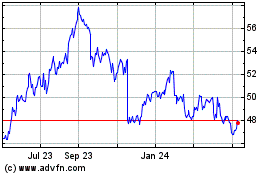Cisco Avoids Negative Impact Of Tariffs -- WSJ
15 November 2018 - 7:02PM
Dow Jones News
By Jay Greene and Maria Armental
This article is being republished as part of our daily
reproduction of WSJ.com articles that also appeared in the U.S.
print edition of The Wall Street Journal (November 15, 2018).
Cisco Systems Inc. is one of a few tech giants under threat from
the Trump administration's trade fight with China, but the company
said it has evaded damage from tariffs so far.
"I haven't had one conversation with any customer around the
tariffs at this point," Chief Executive Chuck Robbins told analysts
Wednesday after the networking-gear company reported its
fourth-consecutive quarter of growth following eight quarters of
declines.
Still, the company is taking steps to mitigate possible
financial fallout from a tariff increase scheduled for the start of
the new year, moving some manufacturing away from China.
A collection of switches and routers, some of which Cisco makes
in China and imports to the U.S., were hit with 10% tariffs that
went into effect in late September. A Credit Suisse analyst had
speculated Cisco might actually get a bump in revenue as customers
stock up on its products made in China ahead of even steeper
tariffs slated to go into effect next year.
Cisco reported revenue rose 7.7% to $13.07 billion, topping Wall
Street's forecast of $12.86 billion. Shares, which have
outperformed the market with a 16% increase this year, rose 4.9%
after hours, due in part to growth in the flagship
routers-and-switches business.
While Cisco hasn't felt any pain yet from tariffs, that could
change in January when they are scheduled to jump to 25%. The
increased cost would be a "slight headwind" in the current quarter
as it would hit with one month left in the period, Finance Chief
Kelly Kramer said in an interview.
Cisco will try to pass the costs to customers, she said, but if
they balk and Cisco has to absorb the impact, "it would be a
significant margin hit for us."
The company is working to move some manufacturing of tariffed
goods from China to its plants in other countries, including
Mexico, Ms. Kramer said. That shift could come as soon as May, she
said.
Mr. Robbins told analysts he saw reason for hope in the
resumption of trade negotiations between the U.S. and China in
recent days.
The company expanded its restructuring efforts in the just-ended
quarter, resulting in $300 million in pretax charges. That would
add to a $300 million pretax restructuring hit it announced six
months earlier. Cisco said it laid off nearly 500 workers this
month in customer support as part of the expanded plan.
Cisco has sought to offset sluggishness in its legacy
networking-gear business by acquiring software startups, such as
its $2.35 billion deal for Duo Security Inc. earlier this year.
Still, revenue from its infrastructure-platforms business -- the
company's largest -- rose 9% to $7.64 billion.
Security-segment revenue rose 11% to $651 million. Revenue in
its applications business rose 18% to $1.42 billion.
Cisco said its fiscal first-quarter profit rose 48% from a year
earlier to $3.55 billion. Excluding stock-based compensation and
other items, profit rose to 75 cents a share. Analysts polled by
FactSet expected a profit of 72 cents a share on an adjusted
basis.
For the current quarter, Cisco expects adjusted per-share profit
of between 71 cents and 73 cents, with revenue rising between 5%
and 7%.
Write to Jay Greene at Jay.Greene@wsj.com and Maria Armental at
maria.armental@wsj.com
(END) Dow Jones Newswires
November 15, 2018 02:47 ET (07:47 GMT)
Copyright (c) 2018 Dow Jones & Company, Inc.
Cisco Systems (NASDAQ:CSCO)
Historical Stock Chart
From Mar 2024 to May 2024

Cisco Systems (NASDAQ:CSCO)
Historical Stock Chart
From May 2023 to May 2024
